MB&F x Eddy Jaquet LM Split Escapement Jules Verne: Science Fiction Stories Exquisitely Engraved In Metal
If you are even the slightest bit interested in science fiction, you are very likely to know the name Jules Verne. His most famous works include Around the World in 80 Days, Journey to the Center of the Earth, and steampunk favorite Twenty Thousand Leagues Under the Sea, but if you are anything like me this may be where your familiarity ends. I am only casually informed about the wonder that was Jules Verne.
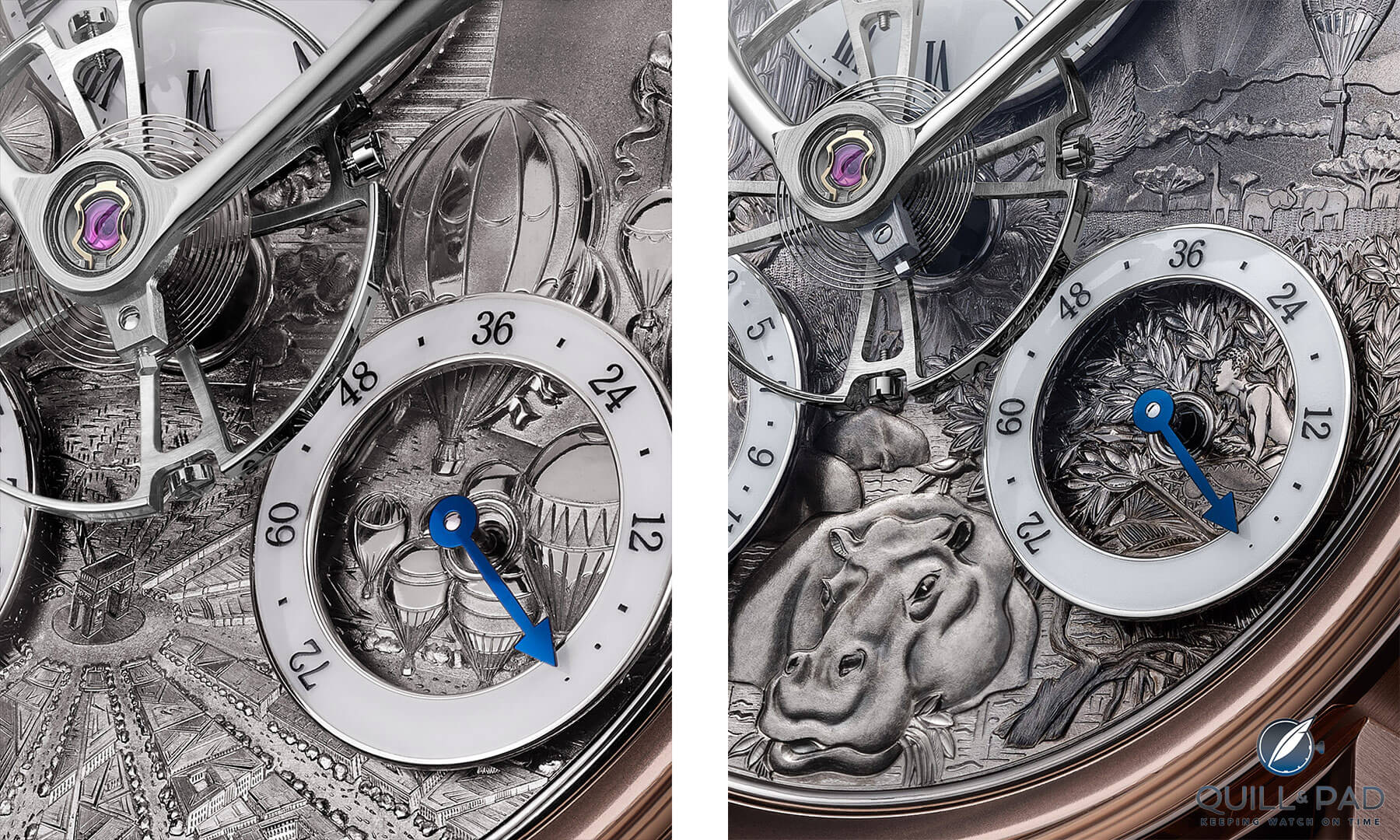
MB&F x Eddy Jaquet LM Split Escapement Jules Verne dial details (‘Robur the Conqueror’ at left; ‘Five Weeks in a Balloon’ at right)
Over his long career Verne published more than 60 novels plus other short stories, plays, and even operas. Most of his most famous work was part of the Voyages Extraordinaires collection, a series of 54 novels published over 42 years until his death in 1905.
Verne’s son, Michel, later published another eight novels that were either completed before Verne’s death or were finished (or completely written) by Michel.
A few more works would be published over the years from early manuscripts or rejected novelizations, with the final book (so far), Paris in the Twentieth Century, having been released in 1994 even though it was written in 1863. It was originally rejected by Verne’s publisher because it seemed “too unbelievable” as it was filled with depictions of cities full of skyscrapers, gas-powered cars, and mass-transit systems, while the main character struggled to live in a technologically advanced but culturally backwards world.
Clearly only the stuff of fantasy, right?
Like many of Verne’s novels it was rather on the nose, showing just how good he was at predicting future technology and advancements and getting the science remarkably accurate with only a layman’s understanding of many topics.
Jules Verne is arguably the father of the entire genre of science fiction, not to mention that he inadvertently inspired many real-world inventions blurring the lines between science fiction and science prophecy. For this reason, Verne holds a special place in the hearts of French speakers (and the world as a whole), representing the spirit of adventure, innovation, and progress.
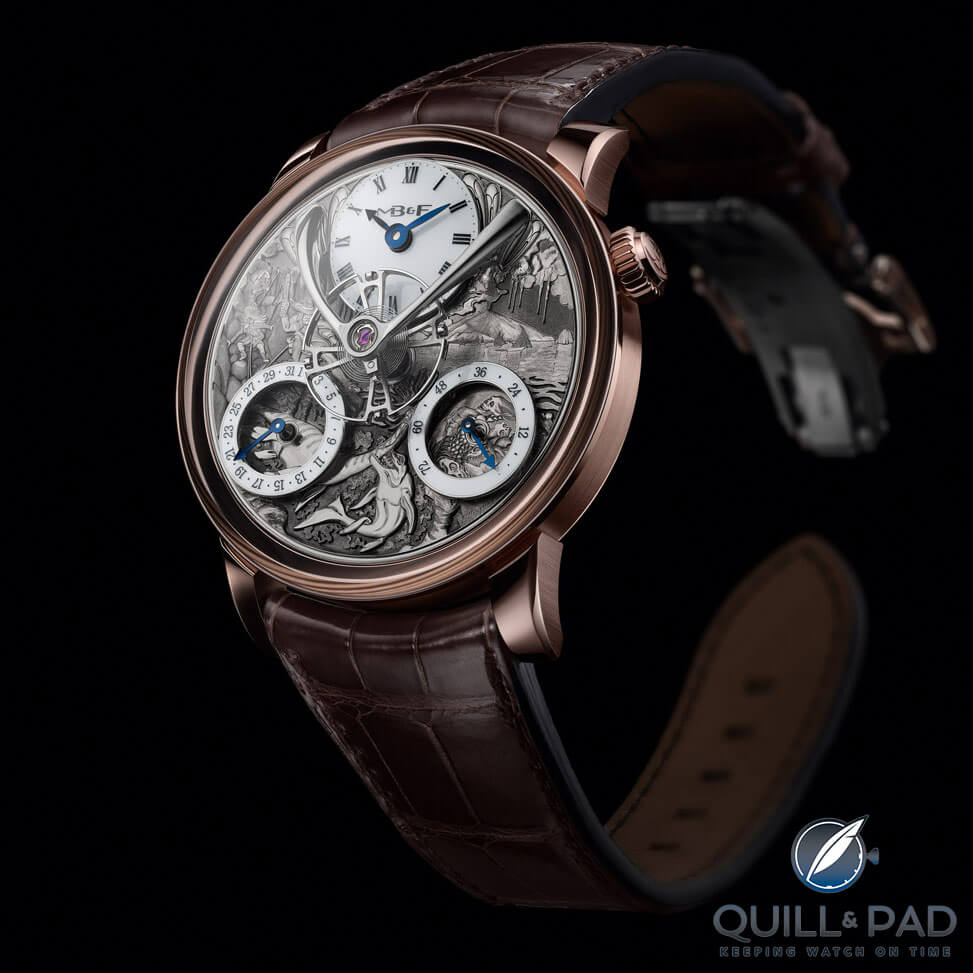
MB&F x Eddy Jaquet LM Split Escapement Jules Verne ‘Journey to the Center of the Earth’
So it’s no surprise that MB&F would create a special limited series of Legacy Machines honoring Jules Verne. It makes perfect sense, especially considering that Legacy Machines themselves are partly inspired by Jules Verne and the type of retro-futurism found within his novels.
Yet this project is also the artistic child of master engraver Eddy Jaquet who has worked with MB&F for the last decade and was the driver behind the endeavor for what to focus on and how to realize it. The result is eight unique Legacy Machine Split Escapement pieces featuring fully engraved dials, each depicting eight different Jules Verne novels. All eight are horological masterpieces befitting a museum exhibition.
MB&F, Eddy Jaquet, and Jules Verne
The collaboration began with a slowdown in projects for master engraver Eddy Jaquet, leading to some brainstorming between MB&F and Jaquet to imagine some projects they might create together. During the brainstorm session Jules Verne came up (obviously), leading to the engraver reading (or rereading) around 60 of Verne’s novels to research and inspire ideas for which stories to focus on.
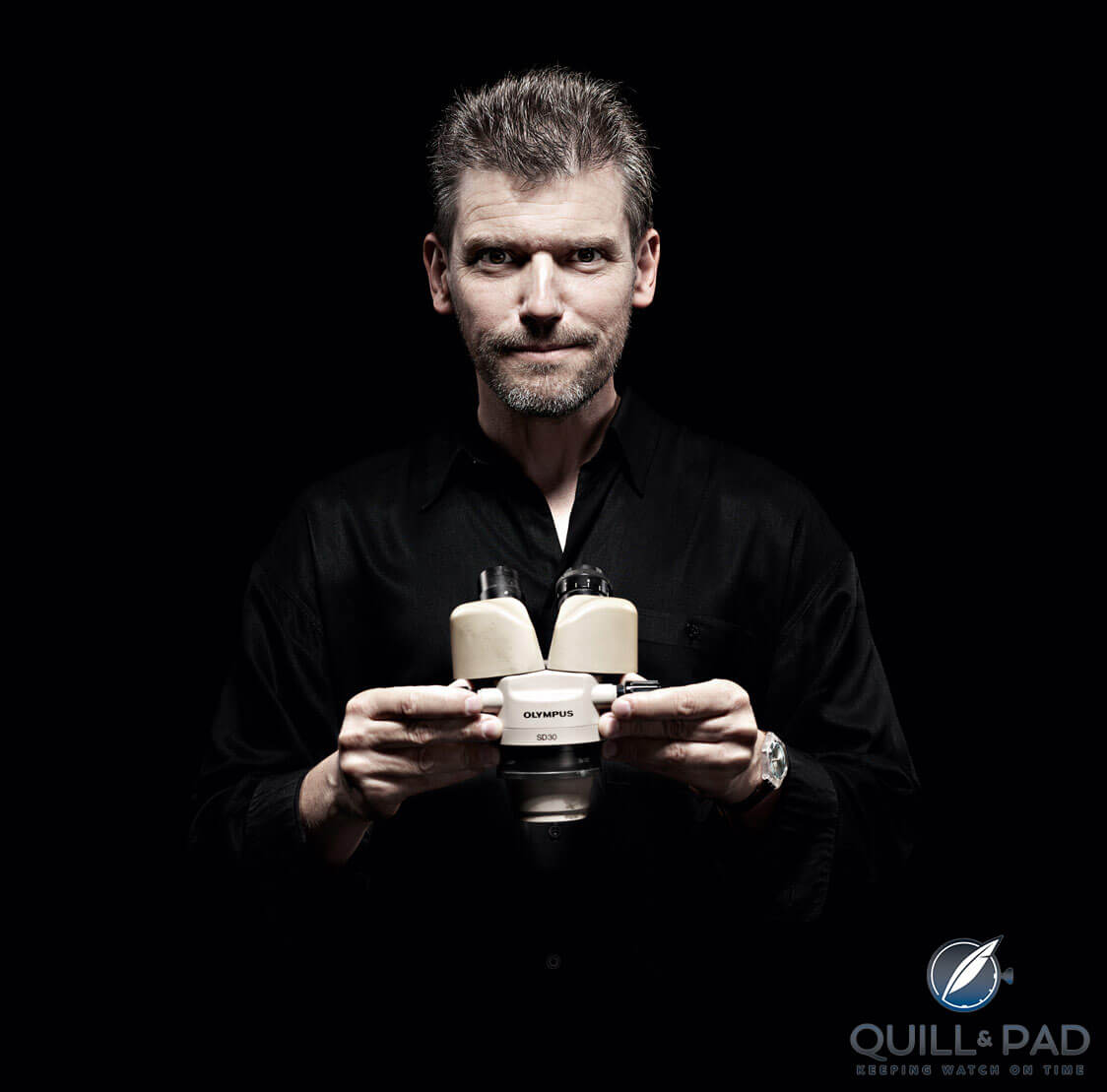
Engraver Eddy Jaquet
The result was a selection including some of the well-known classics and lesser-known stories that only avid Verne fans might recognize.
The plan became to utilize the Legacy Machine Split Escapement as a base to design eight unique pieces highlighting eight novels. Each watch features a collage of scenes from the specific novel illustrating key points and themes present in each story.
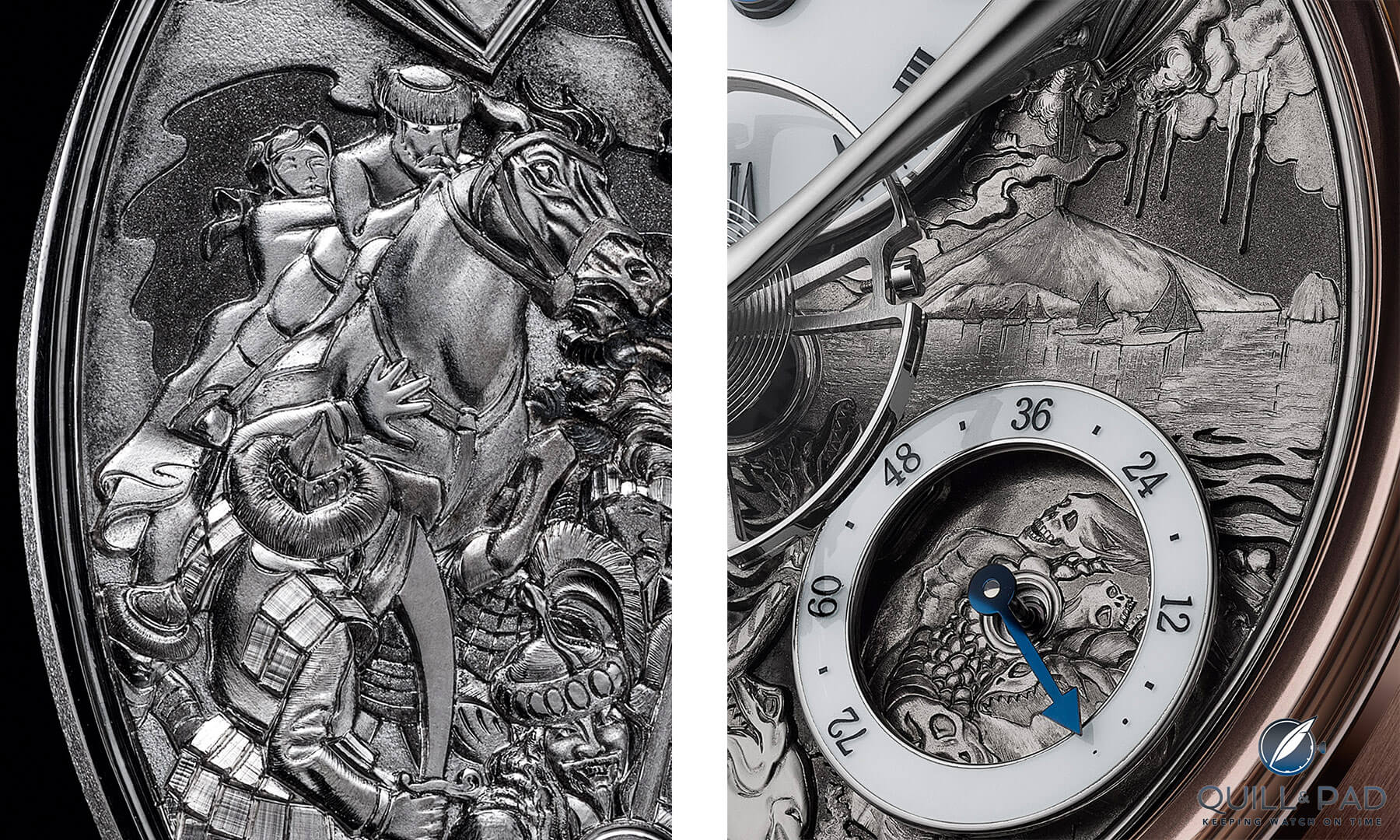
MB&F x Eddy Jaquet LM Split Escapement Jules Verne dial details (‘Michel Strogoff’ at left; ‘Journey to the Center of the Earth’ at right)
The variety of novels chosen captures the breadth of Jules Verne, leading to a smorgasbord of Legacy Machines with some of the finest engravings in the world. Each watch took approximately three months to engrave, resulting in nearly three years’ worth of work to produce the eight different watches.
Naturally, this wasn’t as simple as just engraving a few flat dials that could be slapped onto the front of a movement. How silly to even suggest that: this is MB&F we are talking about.
The first thing making this much more difficult was that the “dial” of the LM Split Escapement is actually the top plate of the movement with functional components mounted to it and a variety of recesses in the back for the gear train underneath. So while the maximum thickness of the plate is 1.15 mm, there are spots measuring a very dainty 0.35 mm, making a deep relief engraving nearly impossible in some spots.
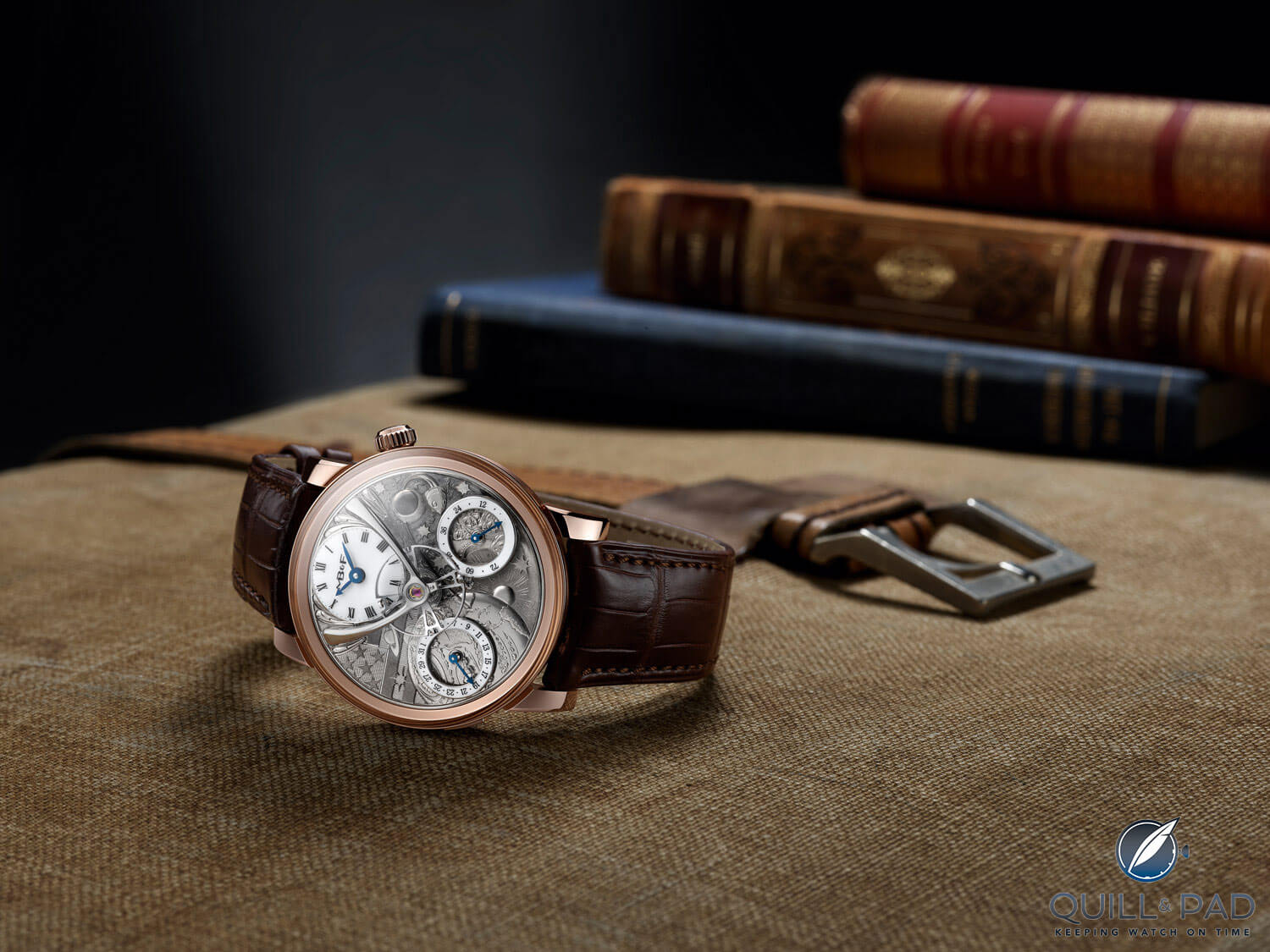
MB&F x Eddy Jaquet LM Split Escapement Jules Verne ‘From the Earth to the Moon’
MB&F x Eddy Jaquet LM Split Escapement Jules Verne: patience, passion, and skill
Jaquet had to very carefully consider the tableau of scenes across the dial and configure the layout to be aesthetically pleasing while working around the features on the front of the dial to ensure that the engravings would not compromise the dial’s structural integrity.
The balancing act demonstrated the Jaquet’s mastery as he created stunning depictions of captivating scenes with incredible depth and contrast, all harmoniously blended with the multiple subdials and the dramatic balance assembly.
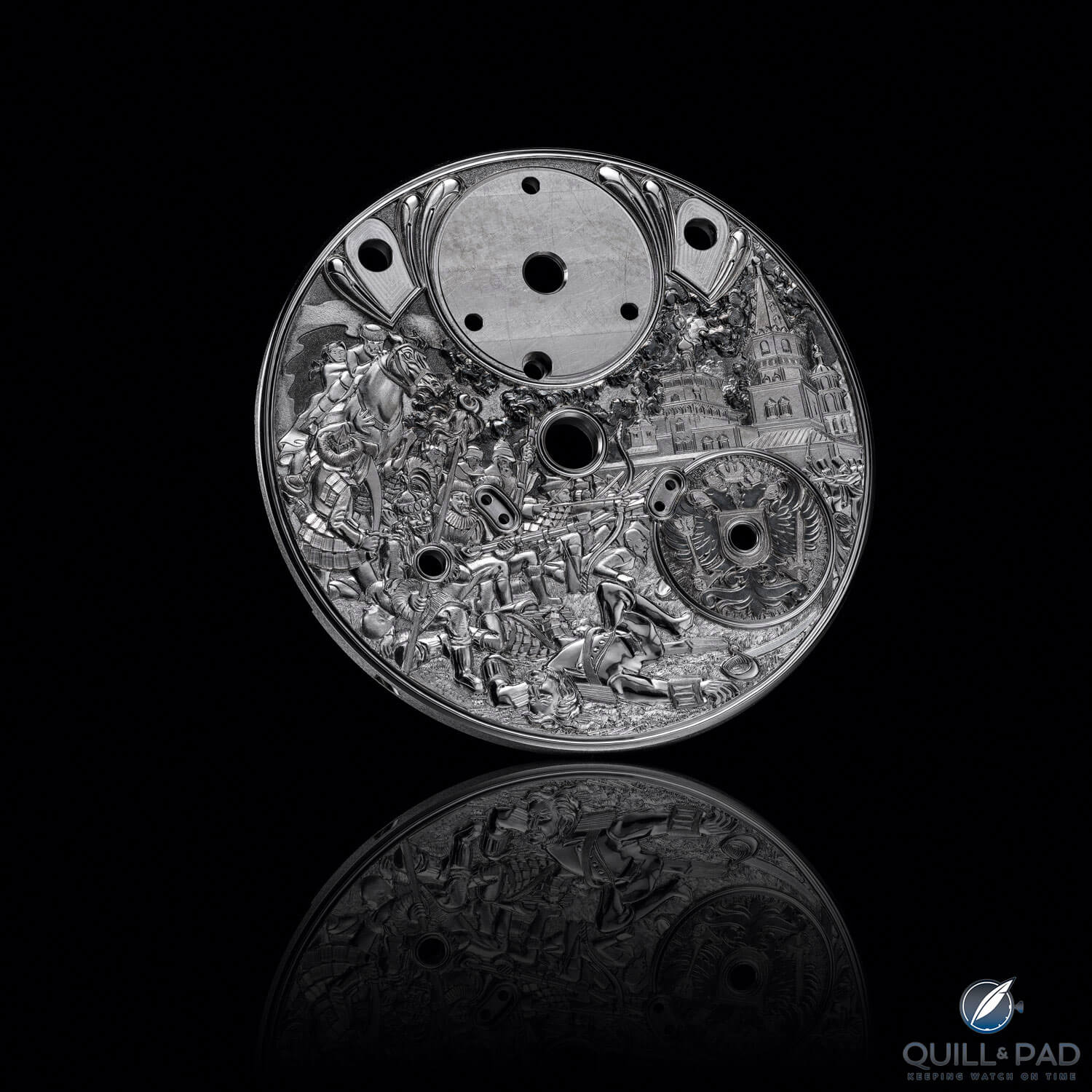
Intricately engraved ‘dial’ of the MB&F x Eddy Jaquet LM Split Escapement Jules Verne ‘Michel Strogoff’
Each one of the eight designs utilizes at least one of the open subdials as a frame to draw focus, and in a few the power reserve dial ring becomes a literal frame for a royal seal, a compass, or as a metaphorical porthole window for characters traveling to the moon in a bullet-shaped projectile. The mounting position of the balance bridge was merged with a flourish design common to each dial, but that was the only standardized element for each of the pieces.
To help out a little with the engraving, the Split Escapement movement was updated to include openworked subdials for the calendar and power reserve, providing more visible surface area.
But even more interestingly, the top plate of the movement increased in diameter, growing larger for still more usable space for engraving. This caused some ripple effects as it meant the case would need to change, the engineers thinning the bezel down and widening the domed sapphire crystal, leading to a less pronounced curve to keep the watch from growing too much in thickness.
Overall, the case is only half a millimeter larger in diameter and 0.7 mm higher compared with the standard version, which shouldn’t change the feeling on the wrist too much.
Origins of the Split Escapement
The Legacy Machine Split Escapement, an evolution of the original Legacy Machine, was developed by Stephen McDonnell, the extremely talented watchmaker behind the groundbreaking LM Perpetual. The Split Escapement distilled the theme of the suspended balance found on the Legacy Machine, removing visual indication of connection to the gear train.
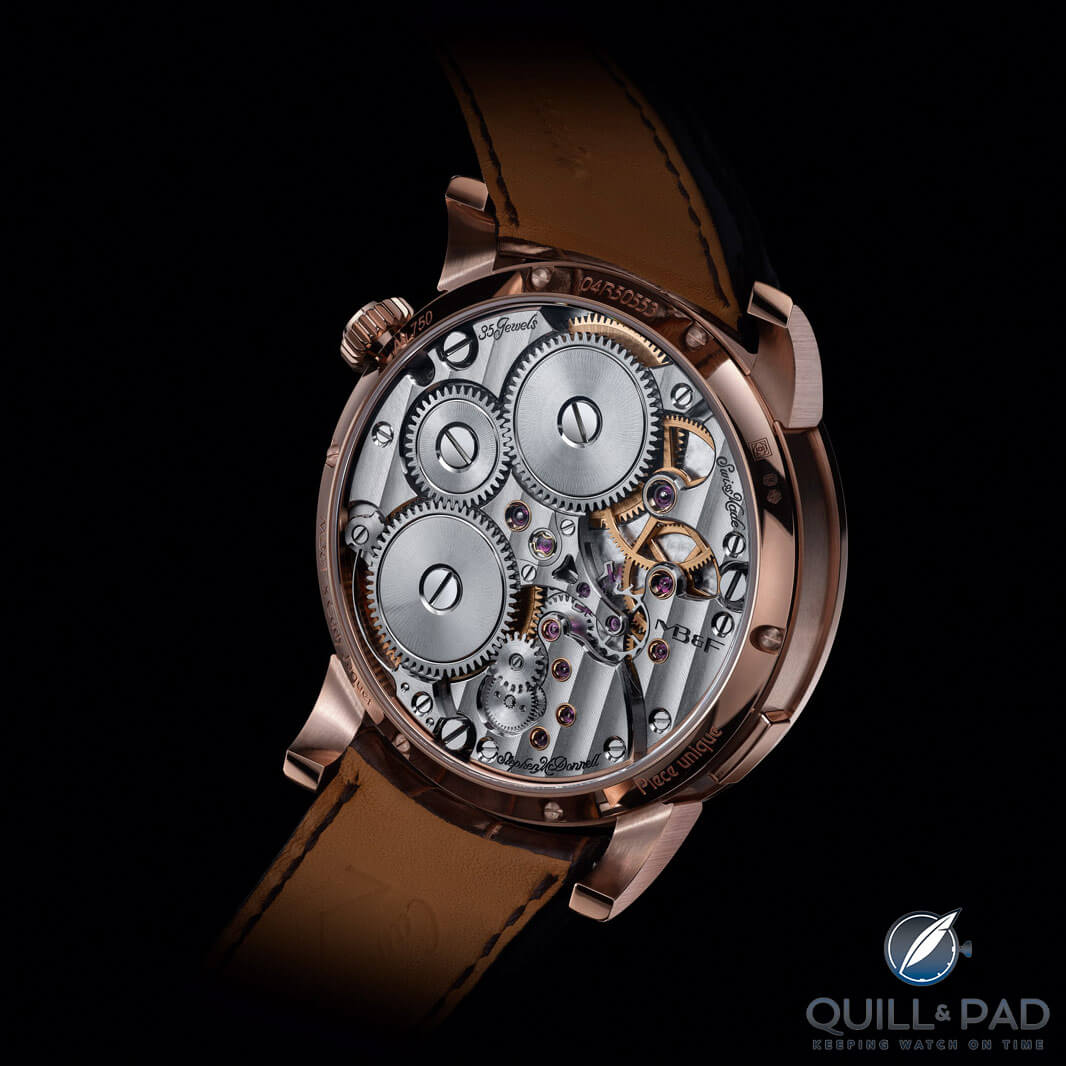
Movement visible through the display back of the MB&F x Eddy Jaquet LM Split Escapement Jules Verne
The escape wheels and pallet lever were transported to the rear of the movement, helping the dial highlight the 2.5 Hz balance and magnifying the illusion of floating above the dial.
This change has created the longest balance staff MB&F has ever made, measuring an astonishing 11.78 mm, which runs through the entire movement. Great care needed to be taken to avoid twisting or warping such a long axle, and the movement also features twin spring barrels to ensure the extra mass (and any inefficiencies introduced by the design) are countered.
The arch supporting the balance has evolved from the earlier Legacy Machines to match that of the LM Perpetual with a very graceful organic shape, almost fluid, as it stretches out over the dial.
The Split Escapement also takes a design cue from the LM101 with a small dial enamel dial for the power reserve, but this time symmetrically with an enamel date dial, both flanking the central balance.
This layout, combined with Split Escapement’s lack of dial side mechanics, allows a wide canvas for Jaquet to work his magic, which is the main reason the Split Escapement was chosen as the vehicle for this collaboration.
The only real change was making the date and power reserve into dial rings, opening up even more real estate for engraving.
MB&F x Eddy Jaquet LM Split Escapement Jules Verne: stories from a different age
Pieces like these are designed just as much with the art in mind; the incredible detail of the dials makes the slight increase in size totally worth it. The real purpose is to share artistic craft and the stories within the engravings.
Jules Verne is such a hugely influential writer that it is a fitting tribute to create a series based on his many novels. The stories chosen also vary in theme to produce a plethora of imagery for the dials. One might think an overarching theme of steampunk science fiction might be on display, but the dials truly capture a century of thought and social ideas both alike and extremely different from our own.
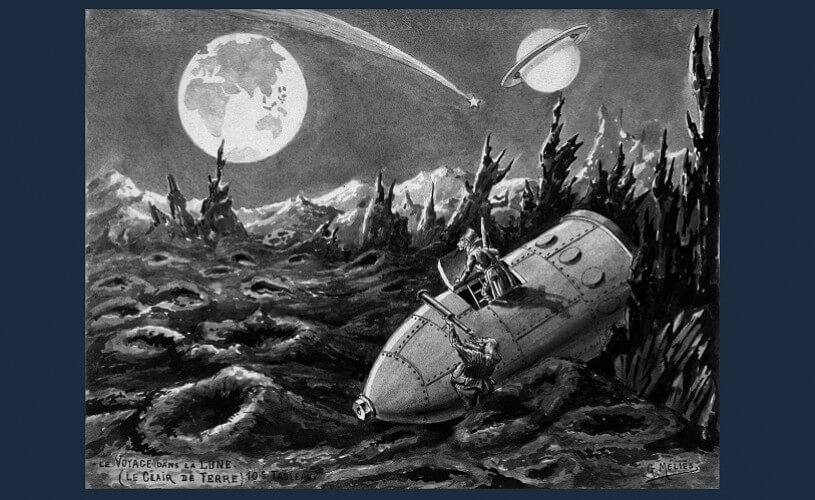
Illustration of ‘The Moon Voyage’ by Jules Verne
Only two of the chosen stories, Robur the Conqueror and Twenty Thousand Leagues Under the Sea, are really stories of hard science fiction featuring wild technologies enabling wondrous adventures.
Robur the Conqueror features a man who created a battery-powered aircraft with multiple vertical propellers that was lightyears ahead of the flight capabilities of the time (lighter-than-air vessels like hot-air balloons and dirigibles). Some say it describes the helicopter before it was invented, but it actually is more akin to either a multirotor drone or even loosely connected to the V22 Osprey.
Twenty Thousand Leagues Under the Sea is the most advanced of the group with extremely complicated and powerful electric submarines (along with other inventions) that foreshadowed the future of underwater exploration.
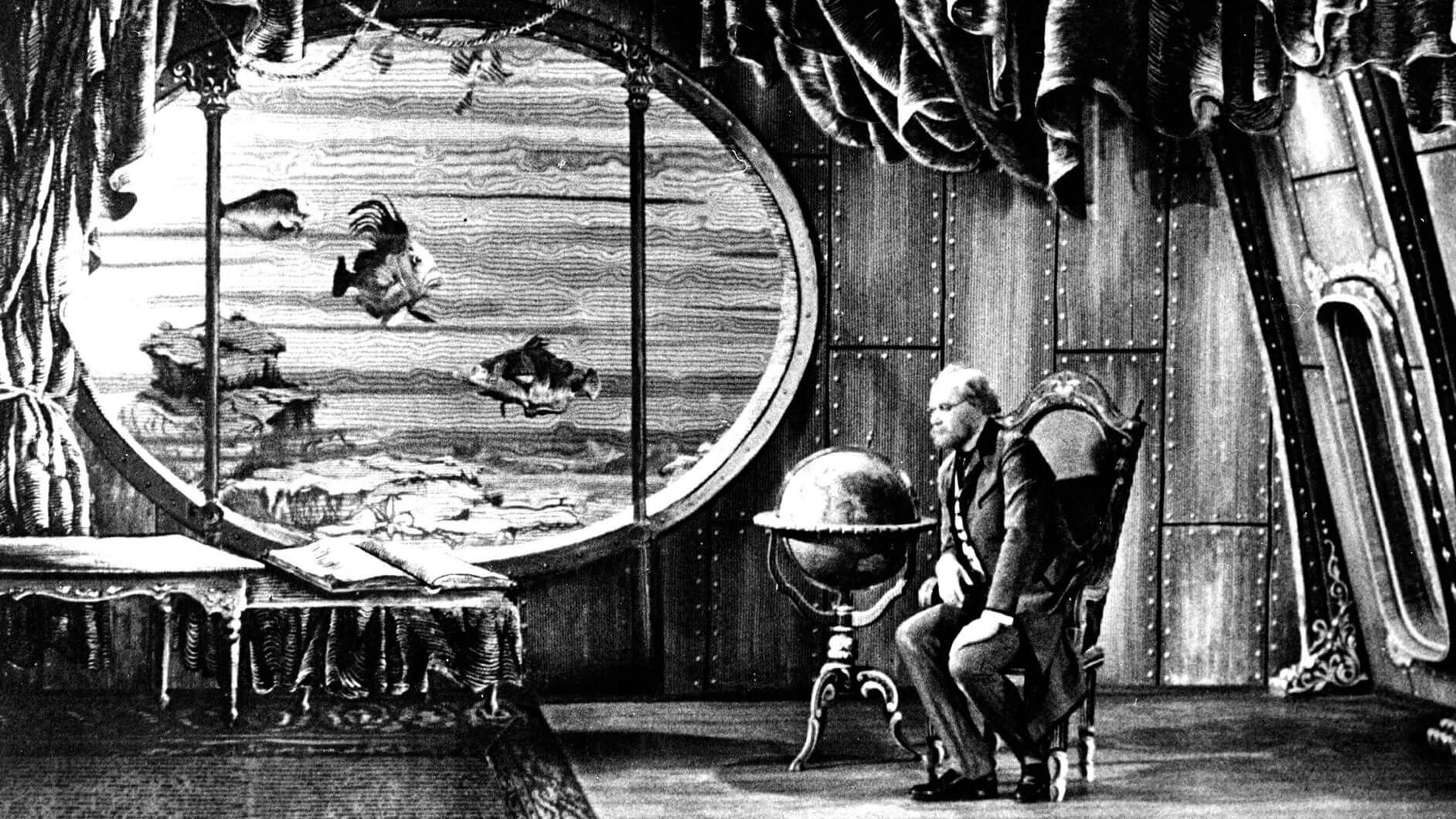
Illustration of ‘Twenty Thousand Leagues Under the Seas’ by Jules Verne
Journey to the Center of the Earth and From the Earth to the Moon are stories that rely more on the current technologies of the day joining fanciful trips that instead provide opportunities to imagine “what if” scenarios. From the Earth to the Moon is about an endeavor to build a ballistic craft to reach the moon, much like a giant cannon.
Journey to the Center of the Earth is really about finding a world that seems impossible – yet it exists and is traversed with basic equipment of the day. These I would argue are soft science fiction, which still pushes the boundaries of what is known but are more technologically plausible in the execution.
The remainders are tales of a more down-to-earth type of adventure. Michel Strogoff follows the Russian rebellion and focuses on political intrigue and war, while The Adventures of Captain Hatteras is about an expedition to the North Pole and what occurs along the very treacherous way.
Five Weeks in a Balloon is an adventure of the then largely unknown continent of Africa via a somewhat advanced hot air balloon. This again focused more on the situations and less on the technology that made it happen but was nonetheless riveting at the time.
MB&F x Eddy Jaquet LM Split Escapement Jules Verne: finishing touches
Finally, one of the most well-known novels from Jules Verne, Around the World in Eighty Days, features a classic race against the clock where nothing goes exactly as planned but is accomplished very mundanely using transportation of the day.
Jaquet has expertly captured the journey with his skill and artistic eye for composition. In fact, every single dial is a perfect encapsulation of the core of each story, and this is made better with additional hand shading.
Using a jeweler’s electroplating pen, Jaquet carefully applied dark-grey rhodium plating to play with contrast, especially visible in the smoke coming from a burning building on the Michel Strogoff edition or the darkness of space on the From the Earth to the Moon dial.
It not only requires a patient touch to add this detail, it also requires a keen artistic eye to know how much and where it should go to really emphasize the engravings. In the end, it all came together to make the engravings feel as real and expressive as possible.
Since every scene was drawn as original artwork by Eddy Jaquet either from whole cloth or inspired by imagery from Verne works over the previous century and a half, each watch is truly a unique masterpiece. And there are no others.
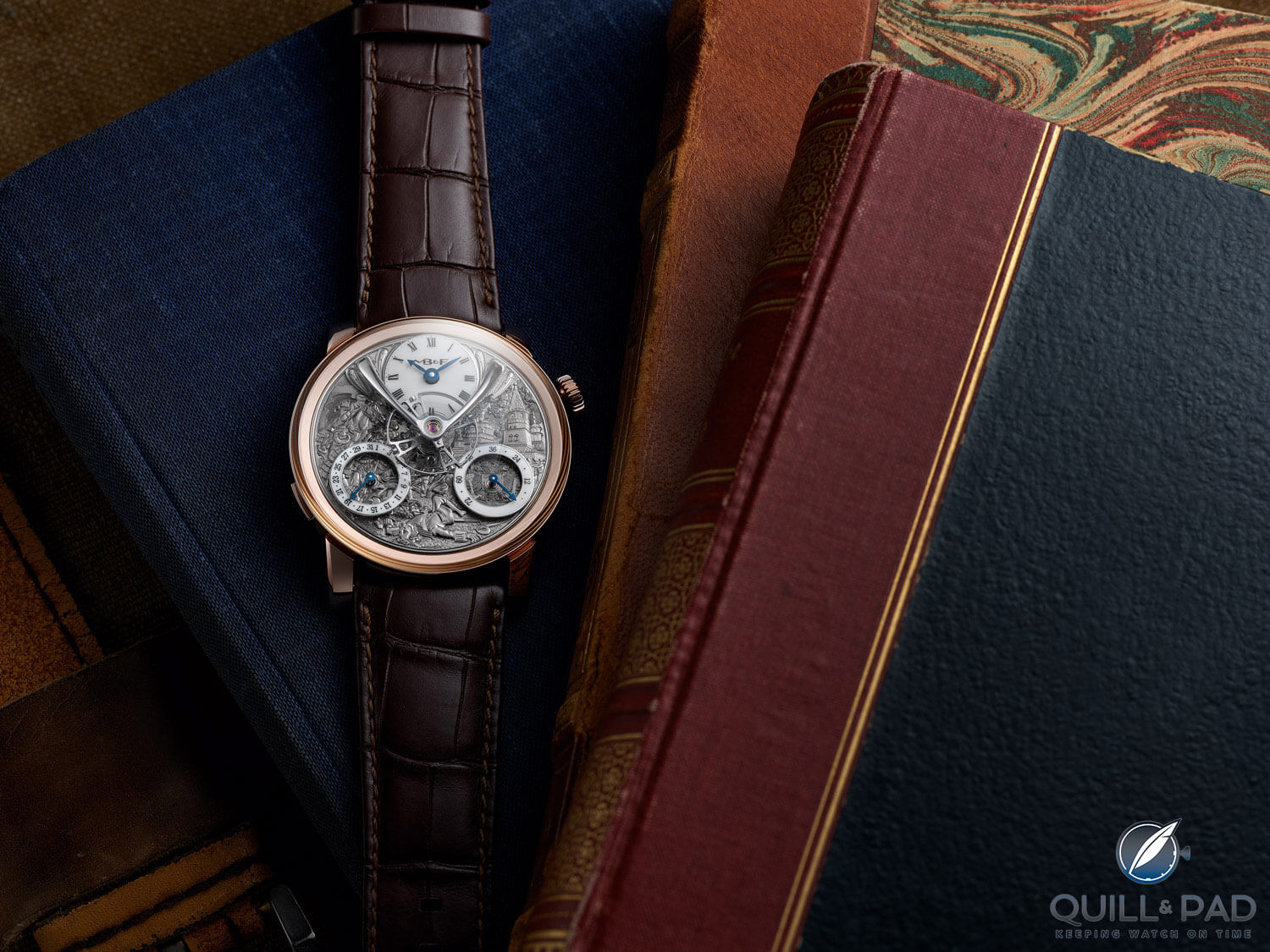
MB&F x Eddy Jaquet LM Split Escapement Jules Verne ‘Michel Strogoff’
This is another level of limited edition compared to the more typical production runs of, say, 20 pieces with a special color on the dial or hand shape. These Legacy Machine Split Escapement Jules Verne watches are terrific examples of the passion and skill of one man applied to a group effort of equally passionate and talented artisans.
MB&F does stand for Max Busser & Friends after all – and here it is obvious that all of his friends showed up to create a set of once-in-a-lifetime pieces.
If you are a fan of Jules Verne then these watches should definitely whet your appetite for all sorts of adventure. But if you are unfamiliar with Verne, then let these watches be your introduction to a wide world of intrigue and technological wonder that are the Voyages Extraordinaires, and you’ll see that the Legacy Machine Split Escapement is a perfect companion for the journey ahead.
It may be a bit of a long journey, so while we venture forth let’s break these down!
- Wowza Factor * 9.94 The LM Split Escapement on its own already gets a very high wow factor, but when you add such a gorgeous dial engraving focused on one of eight different Jules Verne novels then the result nears a perfect score!
- Late Night Lust Appeal * 119.11» 1,168.070m/s2 Well past 1,000 meters per second of acceleration for these pieces will have you plastered to your chair as you drool over the incredible artistry of each unique piece!
- M.G.R. * 71 The LM Split Escapement is one of those movements that is technically not a wild mechanical exercise, but the concept and execution will always blow pretty much anyone away!
- Added-Functionitis * Mild/Moderate With a power reserve and quick-change date, the LM Split Escapement definitely is more than your basic time-only watch so I would recommend some regular strength Gotta-HAVE-That cream for the under-the-radar swelling!
- Ouch Outline * 12.4 The moment a heavy wood plank comes crashing down mere millimeters from your face! Close calls happen all the time, and some really make you stop and think – and take extra precautions next time. While a heavy board battering your shoulder is no fun, the fact that it missed your noggin is something to celebrate. I’d gladly accept that scenario if it meant finding one of these delightful unique pieces on my wrist!
- Mermaid Moment * Wait, did you say Jules Verne?! Some celebrity collaborations leave a lot to be desired, but sometimes one comes along that truly does tickle your fancy. It helps if that celebrity isn’t a modern pop star but a historic figure of classic literature because that cannot possibly ruin your hero. It also helps that one of the best engravers in the game gave us his take on that iconic author with stunning results!
- Awesome Total * 1,068 Start by taking the number of unique pieces in the series (8) and multiply by the new diameter of the case in millimeters (44.5), then multiply the result by the water resistance measured in atmospheres (3) and it will be no surprise that the result is an awesome total that would take you around the world!
For more information, please visit www.mbandf.com/en/machines/performance-art/lmse-eddy-jaquet.
Quick Facts MB&F x Eddy Jaquet Legacy Machine Split Escapement Jules Verne
Case: 44.5 x 18.2 mm, 5N red gold
Movement: manual winding Caliber LM SE developed by Stephen McDonnell, 72 hours power reserve, 18,000 vph/2.5 Hz frequency, split escapement with balance suspended above dial and anchor and escapement wheel under the movement; twin spring barrels
Functions: hours, minutes; power reserve indicator, date
Limitation: 8 unique pieces based on 8 different Jules Verne novels
Price: $162,000 each
You may also enjoy:
MB&F HM10 Bulldog: Forget The Dog, Beware Of The Owner (Video)
MB&F + L’Épée 1839 TriPod: An MB&F Robocreature (Love) Story
MB&F, L’Épée 1839, Massena Lab’s T-Rex Bronze: The Missing Link
Hands On & Live Photos: MB&F x H. Moser LM101 And H. Moser x MB&F Endeavour Cylindrical Tourbillon
Leave a Reply
Want to join the discussion?Feel free to contribute!



Very nice